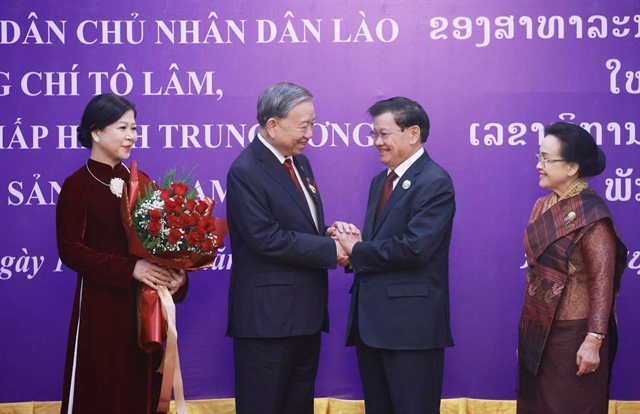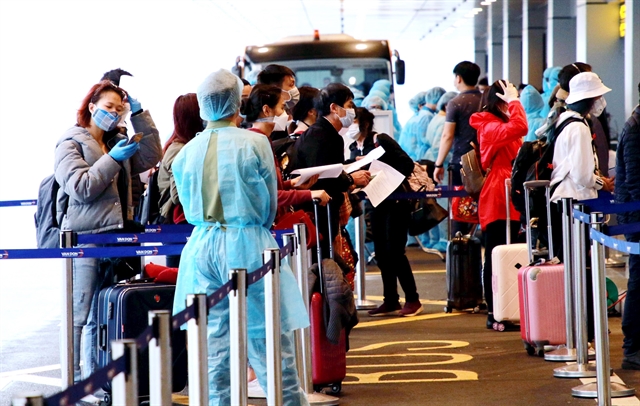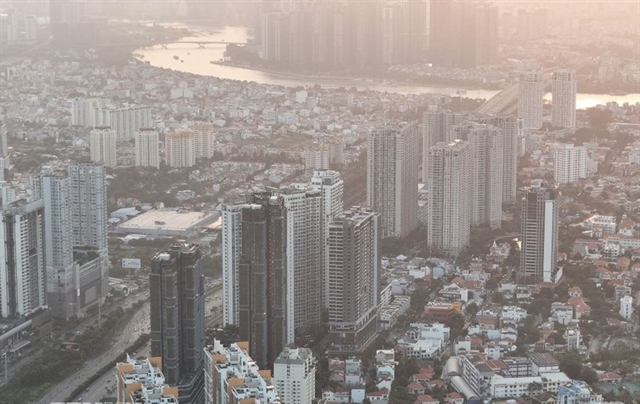 Opinion
Opinion

With quarantine sites across Hà Nội full, many flights destined for Nội Bài Airport are being diverted to Vân Đồn Airport in Quảng Ninh Province. Vietnam News Agency talks to the airport’s director Phạm Ngọc Sáu about the safety protocols being implemented to prevent the spread of COVID-19.

|
| Vietnamese nationals returning from Frankfurt, Germany waiting for their turn to complete procedures outside Vân Đồn airport's terminals on March 25. — VNA/VNS Photo |
With quarantine sites across Hà Nội full, many flights destined for Nội Bài Airport are being diverted to Vân Đồn Airport in Quảng Ninh Province. Vietnam News Agency talks to the airport’s director Phạm Ngọc Sáu about the safety protocols being implemented to prevent the spread of COVID-19.
Foreign tourists and Vietnamese nationals returning to the country have tested positive for COVID-19. What has been Vân Đồn Airport’s experience in this regard?
Vân Đồn has developed a special set of procedures to deal with flights from virus-hit regions that take place outdoors or on the airport apron without affecting activities in the terminals.
The planes land in distant lots and special buses carry the passengers to a designated zone outdoors where all the procedures are conducted, including thermal scanning, health declaration forms, immigration or customs procedures, and baggage claim. Then all passengers are transported to quarantine camps by military vehicles.
We have kept the time needed to complete the necessary procedures down to about one hour, then the planes are sterilised and all hazardous waste is dealt with. We recently managed to handle three flights from Europe in just two hours.
We believe the current procedures are effective in limiting the risk of infection for staff or between passengers.
“Rescue flights” – ones that are repatriating Vietnamese citizens from overseas – often have their schedules changed at a moment’s notice due to many countries now shuttering their borders and airlines cutting flights. How is the airport coping with that?
In this situation we are the passive party so staff have been told to be on guard. We have made detailed plans and arranged human resources and vehicles and other logistic services, even for emergency scenarios. So far, all the flights landing at Vân Đồn have been handled in line with protocol.
We also have an information task force that has direct contact with related authorities in Quảng Ninh Province – especially the province’s health department. All information is shared swiftly so that a consensus on what to do can be reached in a timely manner so that flights can be received.
Has this closed process and immediate quarantine been effective in preventing the spread of the disease?
Preventing cross-infection between staff and passengers is our highest priority. We have taken into account even the smallest details, including installing mobile toilets so that passengers don’t have to take a break during the drive. Passengers are immediately moved into military vehicles to be carried to quarantine sites, avoiding unnecessary contact.
For example, even if two flights land at the same time, we need to make sure that all passengers on one flight are safely in military vehicles destined for quarantine before the next plane is handled to minimise the risks of infection between the two flights.
Co-ordination is also important, so the duties of each unit are clearly defined to prevent gaps and overlaps that might undermine the speed of the entire process.
How has experience in dealing with past outbreaks such as MERS-CoV, Influenza A(H1N1) and Ebola helped?
Prior to the official release of the health ministry’s detailed guidelines, Vân Đồn Airport had already distributed masks for all staff and passengers, and used disinfectant to sterilise common surfaces in the terminals. Thanks to experience gained from the abovementioned infectious diseases, we were faster coming up with response plans to receive adjusted flights and better informed about the best type of disinfectant to use for the airplanes.
The Government’s response to the outbreak has been swift, robust and exhaustive. As far as I am concerned, to successfully combat a contagion like this, the policies must be clear and implemented stringently from the top leaders to the public. Just one party being negligent of their duties would be enough for the outbreak to spiral out of control.
What have Vân Đồn’s managers been doing to alleviate staff concerns?
Given the nature of the disease, everyone is anxious. The airport’s leaders have not asked staff to undertake risky jobs without proper protective gear. We have the responsibility to find the safest approach and issue guidelines and give clear instructions, which I think is one of the ways to give them peace of mind while they are carrying out their duties.
The staff know the different ways COVID-19 can spread from human to human. We must also reassure them that despite receiving batches of passengers from virus-hit regions, given the frequent sterilisation of the airport, this place is still a rather safe environment.
And of course we always encourage the staff, stressing that their jobs are meaningful contributions to society and the community. Vân Đồn International Airport is doing its part in the national effort to combat COVID-19 and ward off cross-infection. The staff now are committed to their duties, and have a sense of patriotic pride about their contributions.
What story has touched you most during this time?
I am incredibly moved by the commitment of my staff. They may already be worn out from serving the scheduled flights during the day, but they are still more than ready to receive the emergency “rescue flights” no matter at night or in the early morning, or the harsh weather. And then they might take a little rest before resuming their daily duties.
“It’s truly tiring, but we are always on alert,” one of them told me.
But if there has to be a memorable image, it must be the sight of one of our female staff in full protective gear, carrying a baby returning from South Korea, feeding her milk and trying to make her stop crying while her mother was busy with landing procedures. — VNS




